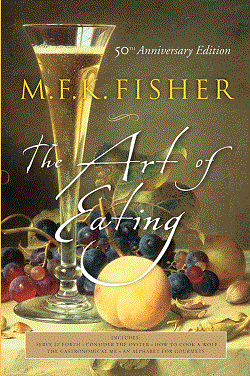“Is there any lover of food or prose who hasn’t already read The Art of Eating?” I asked myself, while ordering a new copy of M. F. K. Fisher’s classic compilation. Although I’d read it many times I wanted to reread it, but my book was overloved and missing half its pages. I ordered the 50th Anniversary Edition, and when it arrived I took it to bed and cracked it open, excited, as if reading it for the first time. That’s the crux of my attachment to this tome: it simultaneously feels like an old friend, and a new one. When I read Fisher’s words now I still feel the same sense of discovery and enchantment I’ve felt since the first time I read her words, way back when I was too young to understand their complexities.
This new edition contains an insightful introduction by Clifton Fadiman, a retrospective essay by Joan Reardon (Fisher’s biographer), and memories from Fisher’s daughters, Anna and Kennedy, and her sister Norah. Appreciation from James Beard, Alice Waters, Julia Child, and other Fisher admirers round out the roster.
If I could have only two books to read for the rest of my life, The Art of Eating—comprised of Fisher’s Serve it Forth, Consider the Oyster, How to Cook a Wolf, The Gastronomical Me, and An Alphabet of Gourmets—would be one of them. (The other would be Up in the Old Hotel.) It is an enormous book, with deeply researched topics, sharp-eyed observations, matter-of-fact declarations, intimate ponderings, and a most confident voice, the perfect antidote to cooking in the digital age, where everyone can, and too often does, declare themselves an expert.
We are bombarded by food bloggers, diners posting photos of their meals on social media, the so-called food porn of Pinterest, and developments such as 3-D food printing and edible rice paper QR codes, to say nothing of kale overload and hipsters lining up to fork over six dollars for a slice of toast.
The Art of Eating is the opposite of all that, yet it is also the analog version of all that, too. I can’t help but wonder whether, if Fisher were alive today, she would be a social media maven. The way she writes about food makes me wish there were a blogger whose posts could compare, so that I could read such satisfying words every day. When she describes a luxurious and abundant meal eaten alone in an empty restaurant, served by an earnest, nearly obsessed young waitress, I can picture the waitress in stark detail, and almost taste every course she sets down. But oh, how I’d love to see Fisher’s Instagram feed of that feast! I imagine her Facebook posts would be full of humblebrags, prone as Fisher was to casting herself as the star of close to every essay. Her pithy passages, always on point, might turn Twitter on its beak:
“We sink too easily into stupid and overfed sensuality, our bodies thickening even more quickly than our minds.”
“Probably one of the most private things in the world is an egg before it is broken.”
“First we eat, then we do everything else.”
“But if I must be alone, I refuse to be alone as if it were something weak and distasteful, like convalescence.”
It is cliché, as well as erroneous, to say that anything, including food, is “comfort food.” Comfort is not always universal. When I’m exhausted and hungry, I want chilaquiles dotted with Frank’s Red Hot. I suspect others would not find this dish as welcome. What I do know is that for anyone who likes good words, good food, and good writing, The Art of Eating is a comfort. It is also a testament to Fisher’s awareness that her life experience was interesting, and meant to be shared, sometimes with embellished brushstrokes. She managed to form a tight confidence with her audience, even while keeping her reserve.
The Art of Eating is an education, an inspiration, a reminder of times and recipes past, and confirmation of the intense connection between our hungers, our hearts, and our souls. I envy you if you’ve yet to read it. Please do. You’re about to make a lifelong friend.







